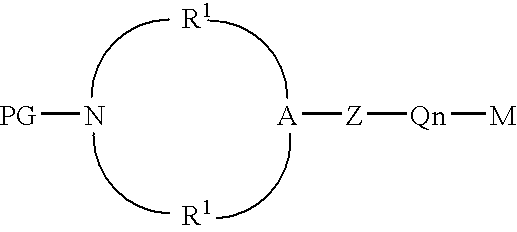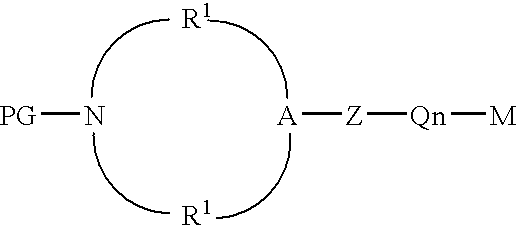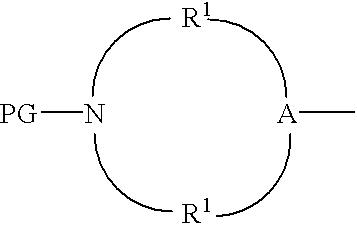Protected aminofunctionalized polymerization initiators and methods of making and using same
- Summary
- Abstract
- Description
- Claims
- Application Information
AI Technical Summary
Benefits of technology
Problems solved by technology
Method used
Image
Examples
example 1
Preparation of 3-(4-Benzylpiperazine)-1-chloropropane
[0138]To a stirred suspension of K2CO3 (248 g, 1.8 mole) in cyclohexane (184 g) and 1-bromo-3-chloropropane (“BCP”) (492 gms, 3.1 mole) was added dropwise over a period of 1 hour at 20° C. 1-benzylpiperazine (300 g, 1.7 mol). After complete addition the reaction was allowed to stir for an additional 20 hours at 25° C. The crude reaction mixture was filtered and then washed with saturated NaCl (3×100 mL). The organic phase was extracted with 3N HCl (3×100 mL). The resulting aqueous phase, containing the desired product as the hydrochloric salt, was washed with hexanes (3×100 mL) to remove any residual BCP. The aqueous phase was subsequently basified with 50 wt % NaOH and extracted with cyclohexane (3×100 mL). After solvent removal 280 g (32% yield) of the title compound was isolated as a yellow oil.
example 2
Preparation of 3-(4-Benzylpiperzine)-1-propyllithium Chain Extended with 2 Moles of Isoprene
[0139]To a 500 ml Morton / cleave flask reactor under argon atmosphere was added lithium powder (12.11 g, 1.75 mole) and 215 mL of cyclohexane. To a constant addition funnel was added 3-(4-benzylpiperazine)-1-chloropropane (104 g, 0.40 mol) and 86 grams cyclohexane. Immediately before beginning the addition, the lithium metal mixture was heated to 53° C. using a heating mantel. Dropwise addition of the feed solution was performed while maintaining the reaction temperature at 50° C. A cooling bath of hexane, to which dry ice was added periodically, was employed to maintain a reaction temperature between 48° to 51° C. The total addition time was 1.22 hours with an average stirring rpm of 925. The reaction mixture was stirred for 1 hour at 55° C. To the reaction was then added isoprene (61.2 g, 0.9 mol) over a period of 1 hour. After the addition was complete the reaction was allowed to stir an ad...
example 3
Preparation of Protected-Alpha-3° Amine Functionalized Polyisoprene
[0140]A 500 ml. glass reactor is equipped with three break-seal reagent ampoules, a sampling port attached with a Teflon® stopcock, an inlet tube fitted with a septum cap, and a magnetic stir bar. This reactor is flame sealed to a high vacuum line, and evacuated at 120° C. for 8 hours. The flask is refilled with dry argon, and allowed to cool to room temperature. The reactor is charged with purified cyclohexane (195 g) and 0.24 grams of a 14.0 wt % solution of 3-(4-benzylpiperazine)-1-propyllithium chain-extended with 2 moles of isoprene per mole of organolithium in cyclohexane. The reactor is then flame sealed off. Diethylether 23 grams (0.31 mole) is added from a break-seal ampoule. Purified isoprene monomer (10.20 grams, 150 mmoles) is added from a break-seal ampoule. The reaction mixture is stirred for twenty four hours at room temperature. The living, functionalized poly(isoprenyl)lithium is terminated with dega...
PUM
 Login to View More
Login to View More Abstract
Description
Claims
Application Information
 Login to View More
Login to View More - R&D
- Intellectual Property
- Life Sciences
- Materials
- Tech Scout
- Unparalleled Data Quality
- Higher Quality Content
- 60% Fewer Hallucinations
Browse by: Latest US Patents, China's latest patents, Technical Efficacy Thesaurus, Application Domain, Technology Topic, Popular Technical Reports.
© 2025 PatSnap. All rights reserved.Legal|Privacy policy|Modern Slavery Act Transparency Statement|Sitemap|About US| Contact US: help@patsnap.com



